【RabbitMQ】12 日志监控 & 消息追踪
一、日志和监控
RabbitMQ日志存放目录
[root@localhost ~]# ll /var/log/rabbitmq/ 总用量 176 -rw-r-----. 1 rabbitmq rabbitmq 177947 10月 10 10:21 rabbit@localhost.log -rw-r-----. 1 rabbitmq rabbitmq 0 10月 6 11:35 rabbit@localhost_upgrade.log [root@localhost ~]#
其中 rabbit@localhost.log 是默认日志
就是跑了视频的一些案例,查看下这个日志大小:
[root@localhost ~]# ll -h /var/log/rabbitmq/rabbit@localhost.log -rw-r-----. 1 rabbitmq rabbitmq 174K 10月 10 10:21 /var/log/rabbitmq/rabbit@localhost.log [root@localhost ~]#
查看日志:
[root@localhost ~]# cat /var/log/rabbitmq/rabbit@localhost.log
一部分日志信息:
2021-10-10 09:14:29.123085+08:00 [info] <0.1360.0> accepting AMQP connection <0.1360.0> (192.168.2.209:59929 -> 192.168.2.121:5672) 2021-10-10 09:14:29.158177+08:00 [info] <0.1360.0> Connection <0.1360.0> (192.168.2.209:59929 -> 192.168.2.121:5672) has a client-provided name: connectionFactory#1fe41ea:0 2021-10-10 09:14:29.162086+08:00 [info] <0.1360.0> connection <0.1360.0> (192.168.2.209:59929 -> 192.168.2.121:5672 - connectionFactory#1fe41ea:0): user 'test' authenticated and granted access to vhost '/dzz' 2021-10-10 09:14:29.208515+08:00 [erro] <0.1369.0> Channel error on connection <0.1360.0> (192.168.2.209:59929 -> 192.168.2.121:5672, vhost: '/dzz', user: 'test'), channel 1: 2021-10-10 09:14:29.208515+08:00 [erro] <0.1369.0> operation basic.publish caused a channel exception not_found: no exchange 'test-dlx-normal-exchange' in vhost '/dzz' 2021-10-10 09:14:29.226656+08:00 [info] <0.1360.0> closing AMQP connection <0.1360.0> (192.168.2.209:59929 -> 192.168.2.121:5672 - connectionFactory#1fe41ea:0, vhost: '/dzz', user: 'test') 2021-10-10 09:15:33.293469+08:00 [info] <0.1460.0> accepting AMQP connection <0.1460.0> (192.168.2.209:59974 -> 192.168.2.121:5672) 2021-10-10 09:15:33.325804+08:00 [info] <0.1460.0> Connection <0.1460.0> (192.168.2.209:59974 -> 192.168.2.121:5672) has a client-provided name: connectionFactory#1fe41ea:0 2021-10-10 09:15:33.330105+08:00 [info] <0.1460.0> connection <0.1460.0> (192.168.2.209:59974 -> 192.168.2.121:5672 - connectionFactory#1fe41ea:0): user 'test' authenticated and granted access to vhost '/dzz' 2021-10-10 09:15:33.383151+08:00 [info] <0.1460.0> closing AMQP connection <0.1460.0> (192.168.2.209:59974 -> 192.168.2.121:5672 - connectionFactory#1fe41ea:0, vhost: '/dzz', user: 'test') 2021-10-10 09:23:32.352291+08:00 [info] <0.3080.0> accepting AMQP connection <0.3080.0> (192.168.2.209:49457 -> 192.168.2.121:5672) 2021-10-10 09:23:32.390842+08:00 [info] <0.3080.0> Connection <0.3080.0> (192.168.2.209:49457 -> 192.168.2.121:5672) has a client-provided name: connectionFactory#1fe41ea:0 2021-10-10 09:23:32.396644+08:00 [info] <0.3080.0> connection <0.3080.0> (192.168.2.209:49457 -> 192.168.2.121:5672 - connectionFactory#1fe41ea:0): user 'test' authenticated and granted access to vhost '/dzz' 2021-10-10 09:23:32.472165+08:00 [info] <0.3080.0> closing AMQP connection <0.3080.0> (192.168.2.209:49457 -> 192.168.2.121:5672 - connectionFactory#1fe41ea:0, vhost: '/dzz', user: 'test') 2021-10-10 09:28:56.310092+08:00 [info] <0.4273.0> accepting AMQP connection <0.4273.0> (192.168.2.209:63817 -> 192.168.2.121:5672) 2021-10-10 09:28:56.344023+08:00 [info] <0.4273.0> Connection <0.4273.0> (192.168.2.209:63817 -> 192.168.2.121:5672) has a client-provided name: connectionFactory#1fe41ea:0 2021-10-10 09:28:56.349675+08:00 [info] <0.4273.0> connection <0.4273.0> (192.168.2.209:63817 -> 192.168.2.121:5672 - connectionFactory#1fe41ea:0): user 'test' authenticated and granted access to vhost '/dzz' 2021-10-10 09:28:56.402577+08:00 [info] <0.4273.0> closing AMQP connection <0.4273.0> (192.168.2.209:63817 -> 192.168.2.121:5672 - connectionFactory#1fe41ea:0, vhost: '/dzz', user: 'test') 2021-10-10 10:08:57.351330+08:00 [info] <0.6109.0> accepting AMQP connection <0.6109.0> (192.168.2.209:60038 -> 192.168.2.121:5672) 2021-10-10 10:08:57.386253+08:00 [info] <0.6109.0> Connection <0.6109.0> (192.168.2.209:60038 -> 192.168.2.121:5672) has a client-provided name: connectionFactory#1fe41ea:0 2021-10-10 10:08:57.390659+08:00 [info] <0.6109.0> connection <0.6109.0> (192.168.2.209:60038 -> 192.168.2.121:5672 - connectionFactory#1fe41ea:0): user 'test' authenticated and granted access to vhost '/dzz' 2021-10-10 10:08:57.432633+08:00 [erro] <0.6118.0> Channel error on connection <0.6109.0> (192.168.2.209:60038 -> 192.168.2.121:5672, vhost: '/dzz', user: 'test'), channel 1: 2021-10-10 10:08:57.432633+08:00 [erro] <0.6118.0> operation basic.publish caused a channel exception not_found: no exchange 'test-dlx-normal-exchange' in vhost '/dzz' 2021-10-10 10:08:57.448887+08:00 [info] <0.6109.0> closing AMQP connection <0.6109.0> (192.168.2.209:60038 -> 192.168.2.121:5672 - connectionFactory#1fe41ea:0, vhost: '/dzz', user: 'test') 2021-10-10 10:09:07.558078+08:00 [info] <0.6150.0> accepting AMQP connection <0.6150.0> (192.168.2.209:60054 -> 192.168.2.121:5672) 2021-10-10 10:09:07.593389+08:00 [info] <0.6150.0> Connection <0.6150.0> (192.168.2.209:60054 -> 192.168.2.121:5672) has a client-provided name: connectionFactory#1fe41ea:0 2021-10-10 10:09:07.597556+08:00 [info] <0.6150.0> connection <0.6150.0> (192.168.2.209:60054 -> 192.168.2.121:5672 - connectionFactory#1fe41ea:0): user 'test' authenticated and granted access to vhost '/dzz' 2021-10-10 10:09:07.650262+08:00 [info] <0.6150.0> closing AMQP connection <0.6150.0> (192.168.2.209:60054 -> 192.168.2.121:5672 - connectionFactory#1fe41ea:0, vhost: '/dzz', user: 'test') 2021-10-10 10:10:00.327777+08:00 [info] <0.6373.0> accepting AMQP connection <0.6373.0> (192.168.2.209:55163 -> 192.168.2.121:5672) 2021-10-10 10:10:00.374144+08:00 [info] <0.6373.0> Connection <0.6373.0> (192.168.2.209:55163 -> 192.168.2.121:5672) has a client-provided name: connectionFactory#1fe41ea:0 2021-10-10 10:10:00.379347+08:00 [info] <0.6373.0> connection <0.6373.0> (192.168.2.209:55163 -> 192.168.2.121:5672 - connectionFactory#1fe41ea:0): user 'test' authenticated and granted access to vhost '/dzz' 2021-10-10 10:10:00.447322+08:00 [info] <0.6373.0> closing AMQP connection <0.6373.0> (192.168.2.209:55163 -> 192.168.2.121:5672 - connectionFactory#1fe41ea:0, vhost: '/dzz', user: 'test') 2021-10-10 10:21:06.128674+08:00 [info] <0.7521.0> accepting AMQP connection <0.7521.0> (192.168.2.209:63933 -> 192.168.2.121:5672) 2021-10-10 10:21:06.163503+08:00 [info] <0.7521.0> Connection <0.7521.0> (192.168.2.209:63933 -> 192.168.2.121:5672) has a client-provided name: connectionFactory#1d09a04:0 2021-10-10 10:21:06.167597+08:00 [info] <0.7521.0> connection <0.7521.0> (192.168.2.209:63933 -> 192.168.2.121:5672 - connectionFactory#1d09a04:0): user 'test' authenticated and granted access to vhost '/dzz' 2021-10-10 10:21:31.982845+08:00 [info] <0.7608.0> accepting AMQP connection <0.7608.0> (192.168.2.209:63964 -> 192.168.2.121:5672) 2021-10-10 10:21:32.031301+08:00 [info] <0.7608.0> Connection <0.7608.0> (192.168.2.209:63964 -> 192.168.2.121:5672) has a client-provided name: connectionFactory#1fe41ea:0 2021-10-10 10:21:32.035322+08:00 [info] <0.7608.0> connection <0.7608.0> (192.168.2.209:63964 -> 192.168.2.121:5672 - connectionFactory#1fe41ea:0): user 'test' authenticated and granted access to vhost '/dzz' 2021-10-10 10:21:32.091950+08:00 [info] <0.7608.0> closing AMQP connection <0.7608.0> (192.168.2.209:63964 -> 192.168.2.121:5672 - connectionFactory#1fe41ea:0, vhost: '/dzz', user: 'test')
监控面板:
http://服务器IP:15672/
服务器概览情况:

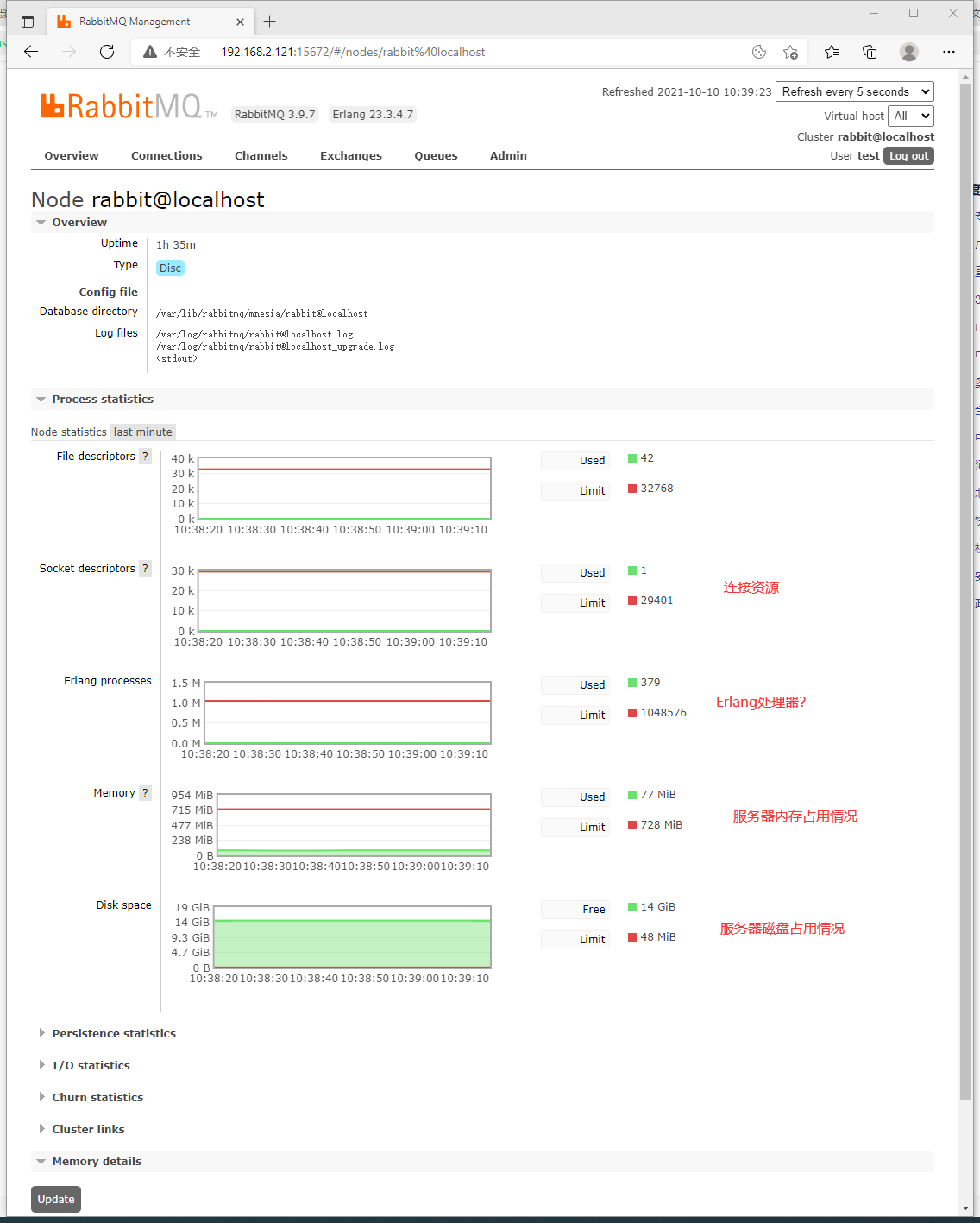
然后是一些用户信息:
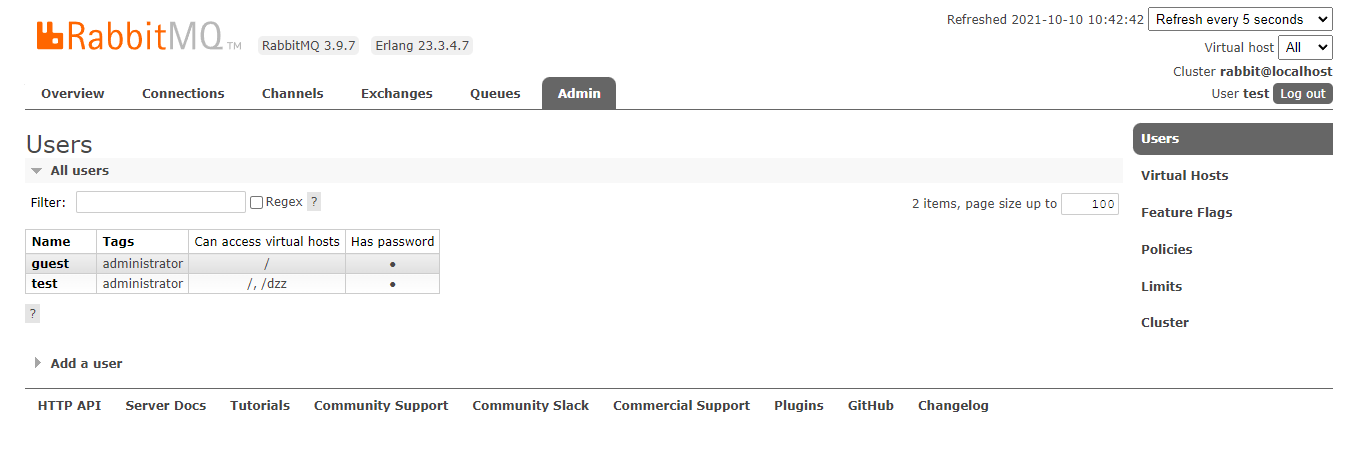
或者使用命令查看:
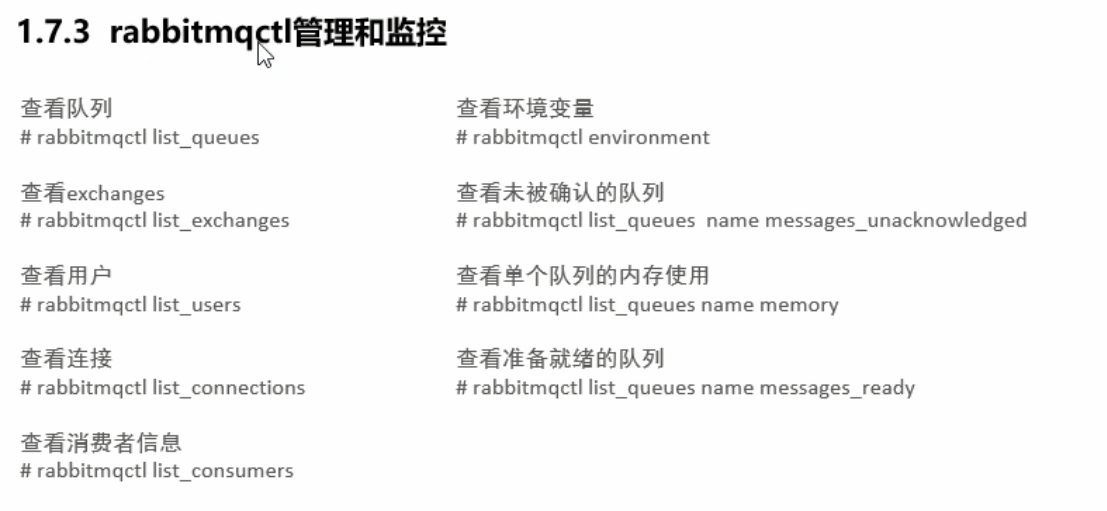
[root@localhost ~]# rabbitmqctl -help Usage rabbitmqctl [--node <node>] [--timeout <timeout>] [--longnames] [--quiet] <command> [<command options>] Available commands: Help: autocomplete Provides command name autocomplete variants help Displays usage information for a command version Displays CLI tools version Nodes: await_startup Waits for the RabbitMQ application to start on the target node reset Instructs a RabbitMQ node to leave the cluster and return to its virgin state rotate_logs Does nothing [deprecated] shutdown Stops RabbitMQ and its runtime (Erlang VM). Monitors progress for local nodes. Does not require a PID file path. start_app Starts the RabbitMQ application but leaves the runtime (Erlang VM) running stop Stops RabbitMQ and its runtime (Erlang VM). Requires a local node pid file path to monitor progress. stop_app Stops the RabbitMQ application, leaving the runtime (Erlang VM) running wait Waits for RabbitMQ node startup by monitoring a local PID file. See also 'rabbitmqctl await_online_nodes' Cluster: await_online_nodes Waits for <count> nodes to join the cluster change_cluster_node_type Changes the type of the cluster node cluster_status Displays all the nodes in the cluster grouped by node type, together with the currently running nodes force_boot Forces node to start even if it cannot contact or rejoin any of its previously known peers force_reset Forcefully returns a RabbitMQ node to its virgin state forget_cluster_node Removes a node from the cluster join_cluster Instructs the node to become a member of the cluster that the specified node is in rename_cluster_node Renames cluster nodes in the local database update_cluster_nodes Instructs a cluster member node to sync the list of known cluster members from <seed_node> Replication: cancel_sync_queue Instructs a synchronising mirrored queue to stop synchronising itself sync_queue Instructs a mirrored queue with unsynchronised mirrors (follower replicas) to synchronise them Users: add_user Creates a new user in the internal database. This user will have no permissions for any virtual hosts by default. authenticate_user Attempts to authenticate a user. Exits with a non-zero code if authentication fails. change_password Changes the user password clear_password Clears (resets) password and disables password login for a user clear_user_limits Clears user connection/channel limits delete_user Removes a user from the internal database. Has no effect on users provided by external backends such as LDAP list_user_limits Displays configured user limits list_users List user names and tags set_user_limits Sets user limits set_user_tags Sets user tags Access Control: clear_permissions Revokes user permissions for a vhost clear_topic_permissions Clears user topic permissions for a vhost or exchange list_permissions Lists user permissions in a virtual host list_topic_permissions Lists topic permissions in a virtual host list_user_permissions Lists permissions of a user across all virtual hosts list_user_topic_permissions Lists user topic permissions list_vhosts Lists virtual hosts set_permissions Sets user permissions for a vhost set_topic_permissions Sets user topic permissions for an exchange Monitoring, observability and health checks: list_bindings Lists all bindings on a vhost list_channels Lists all channels in the node list_ciphers Lists cipher suites supported by encoding commands list_connections Lists AMQP 0.9.1 connections for the node list_consumers Lists all consumers for a vhost list_exchanges Lists exchanges list_hashes Lists hash functions supported by encoding commands list_node_auth_attempt_stats Lists authentication attempts on the target node list_queues Lists queues and their properties list_unresponsive_queues Tests queues to respond within timeout. Lists those which did not respond ping Checks that the node OS process is up, registered with EPMD and CLI tools can authenticate with it report Generate a server status report containing a concatenation of all server status information for support purposes schema_info Lists schema database tables and their properties status Displays status of a node Parameters: clear_global_parameter Clears a global runtime parameter clear_parameter Clears a runtime parameter. list_global_parameters Lists global runtime parameters list_parameters Lists runtime parameters for a virtual host set_global_parameter Sets a runtime parameter. set_parameter Sets a runtime parameter. Policies: clear_operator_policy Clears an operator policy clear_policy Clears (removes) a policy list_operator_policies Lists operator policy overrides for a virtual host list_policies Lists all policies in a virtual host set_operator_policy Sets an operator policy that overrides a subset of arguments in user policies set_policy Sets or updates a policy Virtual hosts: add_vhost Creates a virtual host clear_vhost_limits Clears virtual host limits delete_vhost Deletes a virtual host list_vhost_limits Displays configured virtual host limits restart_vhost Restarts a failed vhost data stores and queues set_vhost_limits Sets virtual host limits set_vhost_tags Sets virtual host tags trace_off trace_on Configuration and Environment: decode Decrypts an encrypted configuration value encode Encrypts a sensitive configuration value environment Displays the name and value of each variable in the application environment for each running application set_cluster_name Sets the cluster name set_disk_free_limit Sets the disk_free_limit setting set_log_level Sets log level in the running node set_vm_memory_high_watermark Sets the vm_memory_high_watermark setting Definitions: export_definitions Exports definitions in JSON or compressed Erlang Term Format. import_definitions Imports definitions in JSON or compressed Erlang Term Format. Feature flags: enable_feature_flag Enables a feature flag or all supported feature flags on the target node list_feature_flags Lists feature flags Operations: close_all_connections Instructs the broker to close all connections for the specified vhost or entire RabbitMQ node close_all_user_connections Instructs the broker to close all connections of the specified user close_connection Instructs the broker to close the connection associated with the Erlang process id eval Evaluates a snippet of Erlang code on the target node eval_file Evaluates a file that contains a snippet of Erlang code on the target node exec Evaluates a snippet of Elixir code on the CLI node force_gc Makes all Erlang processes on the target node perform/schedule a full sweep garbage collection resume_listeners Resumes client connection listeners making them accept client connections again suspend_listeners Suspends client connection listeners so that no new client connections are accepted Queues: delete_queue Deletes a queue purge_queue Purges a queue (removes all messages in it) Deprecated: hipe_compile DEPRECATED. This command is a no-op. HiPE is no longer supported by modern Erlang versions node_health_check DEPRECATED. Performs intrusive, opinionated health checks on a fully booted node. See https://www.rabbitmq.com/monitoring.html#health-checks instead Use 'rabbitmqctl help <command>' to learn more about a specific command [root@localhost ~]#
二、消息追踪
一、追踪原理概述:
大概意思是,追踪的技术层面实现还是依靠这个队列和交换机,这个交换机和队列不是为了生产和业务应用
专门用于记录其他队列的工作情况。
Firehose功能
每个虚拟主机下的交换机都会默认创建一个Trace交换机:

交换机属性:
TOPIC通配符模式
持久化 是
内部使用 是
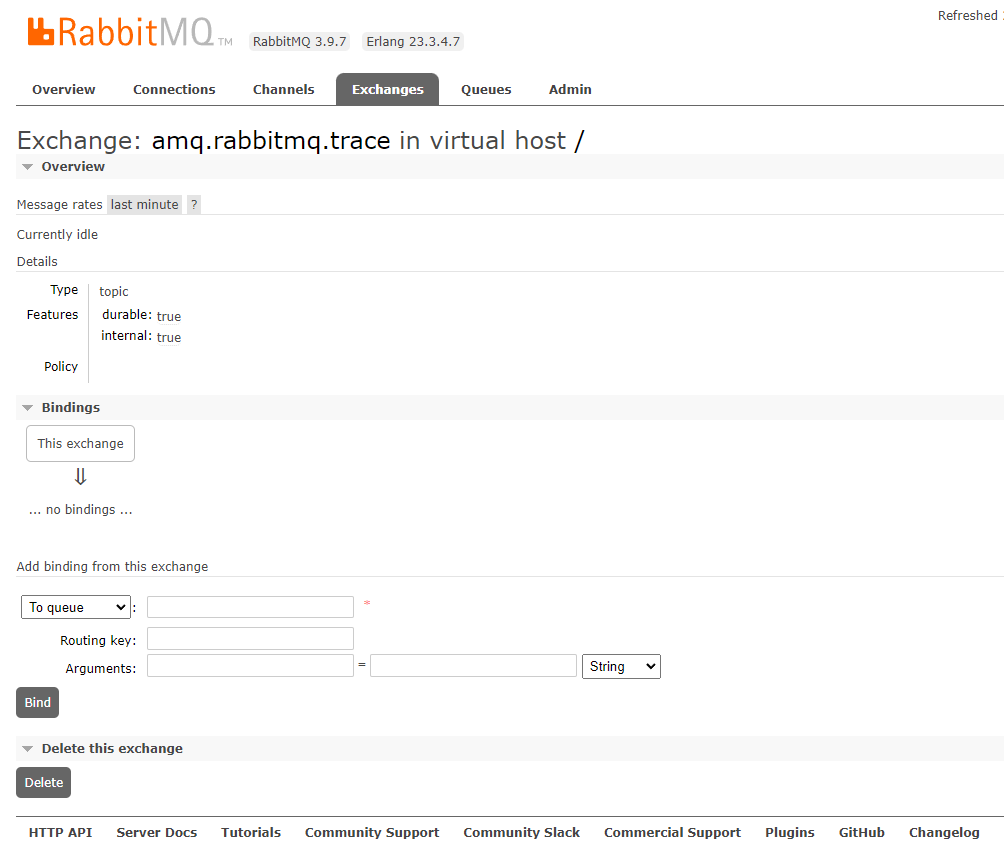
在 / 虚拟主机下创建一个监控队列(使用#路由分配 来监听所有队列)
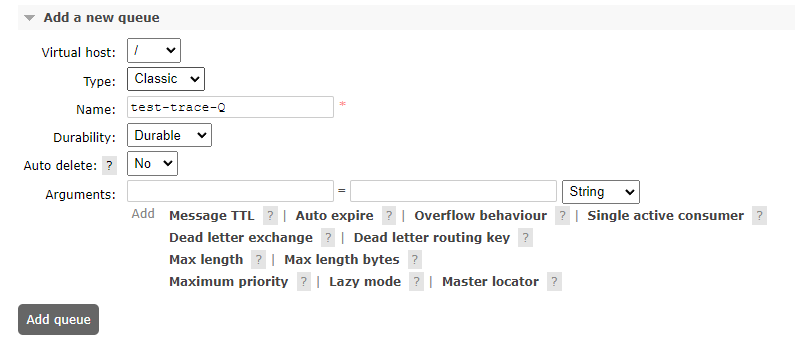
将队列绑定到trace交换机上
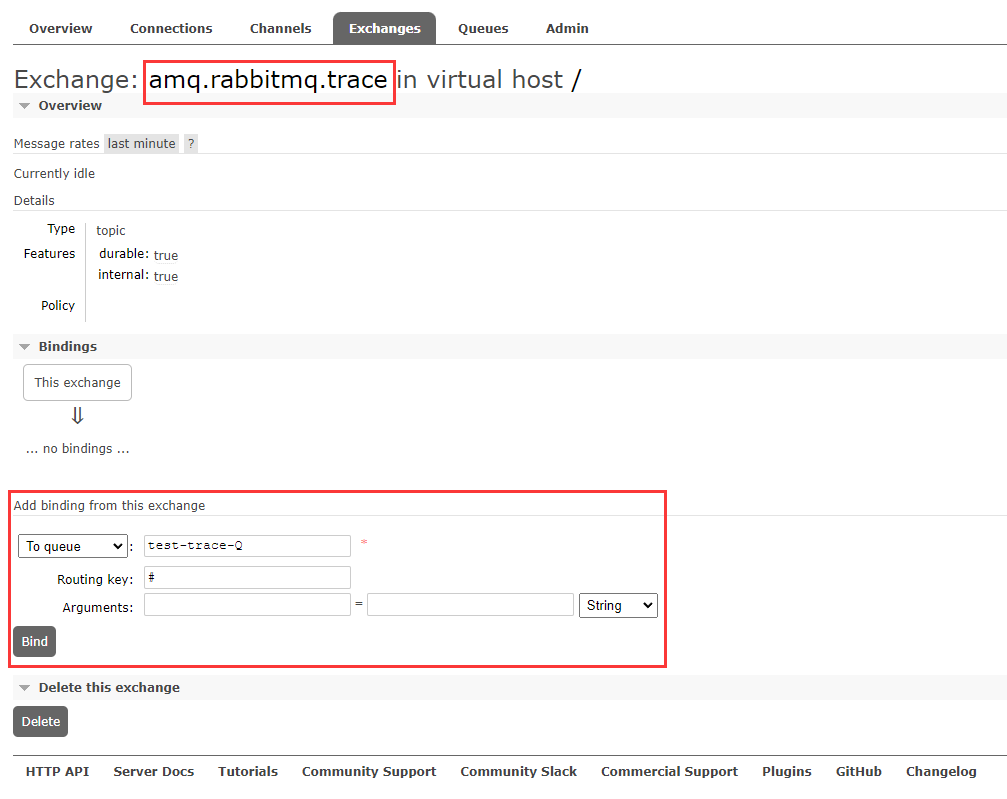
在队列中发送一条消息测试:
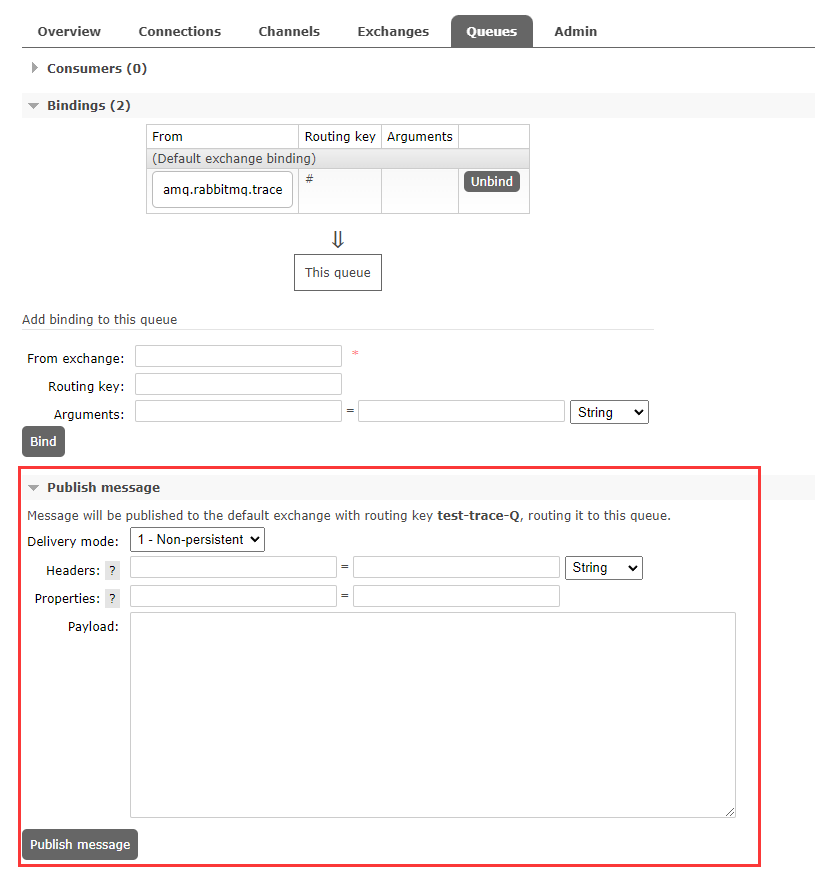
我这多点了2条

https://www.pianshen.com/article/50101743795/
这里可以先查看下Trace功能的状态:
[root@localhost ~]# rabbitmq-plugins list Listing plugins with pattern ".*" ... Configured: E = explicitly enabled; e = implicitly enabled | Status: * = running on rabbit@localhost |/ [ ] rabbitmq_amqp1_0 3.9.7 [ ] rabbitmq_auth_backend_cache 3.9.7 [ ] rabbitmq_auth_backend_http 3.9.7 [ ] rabbitmq_auth_backend_ldap 3.9.7 [ ] rabbitmq_auth_backend_oauth2 3.9.7 [ ] rabbitmq_auth_mechanism_ssl 3.9.7 [ ] rabbitmq_consistent_hash_exchange 3.9.7 [ ] rabbitmq_event_exchange 3.9.7 [ ] rabbitmq_federation 3.9.7 [ ] rabbitmq_federation_management 3.9.7 [ ] rabbitmq_jms_topic_exchange 3.9.7 [E*] rabbitmq_management 3.9.7 [e*] rabbitmq_management_agent 3.9.7 [ ] rabbitmq_mqtt 3.9.7 [ ] rabbitmq_peer_discovery_aws 3.9.7 [ ] rabbitmq_peer_discovery_common 3.9.7 [ ] rabbitmq_peer_discovery_consul 3.9.7 [ ] rabbitmq_peer_discovery_etcd 3.9.7 [ ] rabbitmq_peer_discovery_k8s 3.9.7 [ ] rabbitmq_prometheus 3.9.7 [ ] rabbitmq_random_exchange 3.9.7 [ ] rabbitmq_recent_history_exchange 3.9.7 [ ] rabbitmq_sharding 3.9.7 [ ] rabbitmq_shovel 3.9.7 [ ] rabbitmq_shovel_management 3.9.7 [ ] rabbitmq_stomp 3.9.7 [ ] rabbitmq_stream 3.9.7 [ ] rabbitmq_stream_management 3.9.7 [ ] rabbitmq_top 3.9.7 [ ] rabbitmq_tracing 3.9.7 [ ] rabbitmq_trust_store 3.9.7 [e*] rabbitmq_web_dispatch 3.9.7 [ ] rabbitmq_web_mqtt 3.9.7 [ ] rabbitmq_web_mqtt_examples 3.9.7 [ ] rabbitmq_web_stomp 3.9.7 [ ] rabbitmq_web_stomp_examples 3.9.7 [root@localhost ~]#
应该是这个tracing功能,可以看见标识为 未启用的状态
现在把他打开:
[root@localhost ~]# rabbitmq-plugins enable rabbitmq_tracing Enabling plugins on node rabbit@localhost: rabbitmq_tracing The following plugins have been configured: rabbitmq_management rabbitmq_management_agent rabbitmq_tracing rabbitmq_web_dispatch Applying plugin configuration to rabbit@localhost... The following plugins have been enabled: rabbitmq_tracing started 1 plugins. [root@localhost ~]#
然后设置trace为on
注意下面的输出,它是默认给 / 的虚拟主机添加的
[root@localhost ~]# rabbitmqctl trace_on Starting tracing for vhost "/" ... Trace enabled for vhost / [root@localhost ~]#
如果添加到其他虚拟主机,则是:
-p 参数前缀 加上你的虚拟主机名字
rabbitmqctl trace_on -p myhost
现在再次发送消息:
开启后的消息明显和之前的不一样,会提供详细的信息:

查询全部消息,会发现,会有其他交换机也发送消息:
原来上面的那条是trace帮我发送的,下面的才是我自己发送的
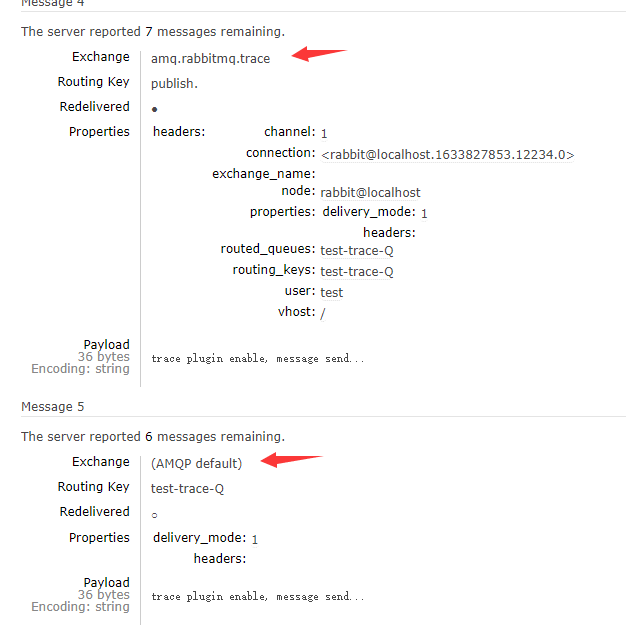
关闭trace功能:
同样如果是其他虚拟主机,加-p前缀 带上主机名称
[root@localhost ~]# rabbitmqctl trace_off Stopping tracing for vhost "/" ... Trace disabled for vhost / [root@localhost ~]#
我发现是我眼睛瞎了???
从【Admin】标签点进去是找不到Tracing功能的
然后又从头上那个 【Cluster】集群主机名点进去,这个Tracing功能才给我展示出来
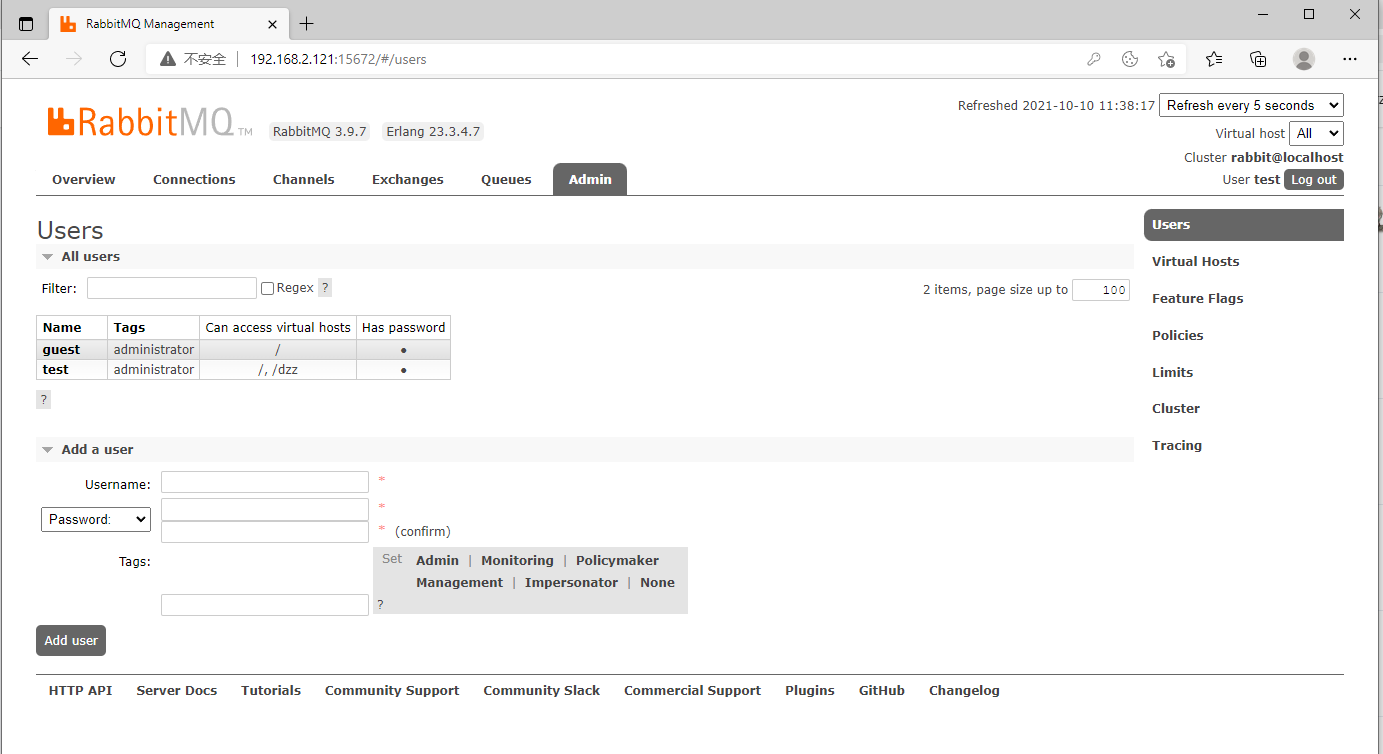
现在新增一个追踪队列(使用Trace面板):

添加之后,会生成一个队列和一个日志:

访问日志文件需要用户授权,输入账号密码访问:
队列是一个专门追踪的队列

现在在之前测试的队列中发送消息 (test-trace-Q):
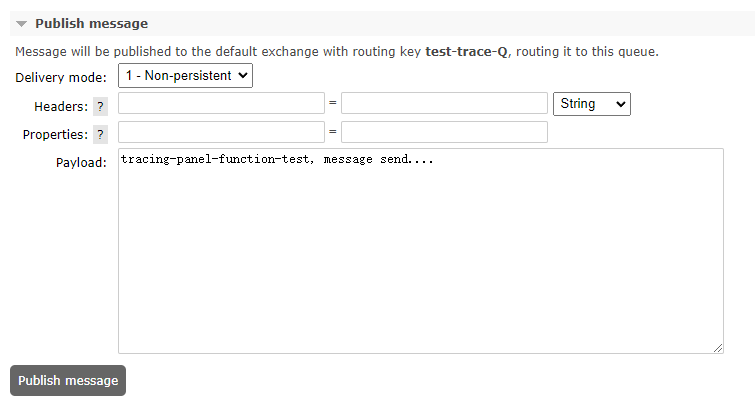
再回去看日志文件

日志信息:
================================================================================ 2021-10-10 3:47:12:050: Message published Node: rabbit@localhost Connection: <rabbit@localhost.1633827853.14098.0> Virtual host: / User: test Channel: 1 Exchange: Routing keys: [<<"test-trace-Q">>] Routed queues: [<<"test-trace-Q">>] Properties: [{<<"delivery_mode">>,signedint,1},{<<"headers">>,table,[]}] Payload: tracing-panel-function-test, message send.... ================================================================================ 2021-10-10 3:49:10:117: Message published Node: rabbit@localhost Connection: <rabbit@localhost.1633827853.14360.0> Virtual host: / User: test Channel: 1 Exchange: Routing keys: [<<"test-trace-Q">>] Routed queues: [<<"test-trace-Q">>] Properties: [{<<"delivery_mode">>,signedint,1},{<<"headers">>,table,[]}] Payload: second message send...
Tracing面板上点击Stop,队列就会被移除,再点击Delete就删除了日志文件



